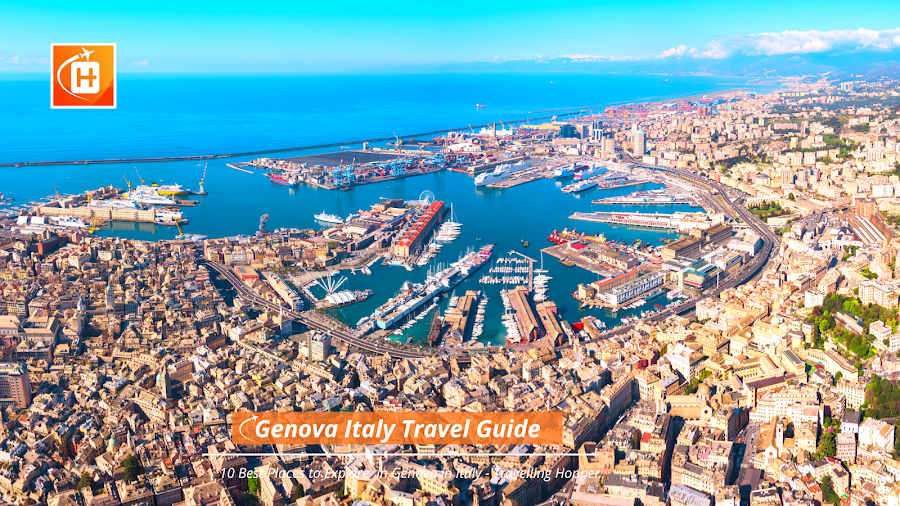Genoa, or Genova in Italian, is a beautiful city located in the northwestern region of Italy in Europe. It is the capital of the Liguria region and a popular destination for travelers interested in history, culture, and architecture.
Why Genova in Italy is famous?
- Being the birthplace of Christopher Columbus, the explorer who discovered America.
- Its historic center, which is a UNESCO World Heritage site and features stunning architecture, museums, and art galleries.
- Its delicious cuisine, which includes dishes such as pesto alla genovese, focaccia, and farinata.
- Its vibrant port, which is one of the busiest in Italy and a hub for cruise ships and cargo vessels.
- Its aquarium, which is one of the largest in Europe and home to over 600 species of marine animals.
- Its role as a major commercial and industrial hub in Italy, with a thriving textile, shipping, and manufacturing sector.
- Its beautiful coastline, which includes charming seaside towns such as Portofino and the Cinque Terre.
- Its contribution to art and culture, with famous painters such as Luca Cambiaso and Rubens hailing from Genoa.
- Its rich history, which dates back to the Roman times and includes periods of rule by the Republic of Genoa and various other kingdoms and empires.
- Its impressive architecture, which includes palaces, churches, and historic buildings that showcase a mix of Gothic, Renaissance, and Baroque styles.
Old Town (Centro Storico): The historic center of Genoa is a UNESCO World Heritage site and a must-visit attraction. It is a maze of narrow streets, alleys, and small squares that lead to stunning churches, palaces, and museums.
Palazzi dei Rolli: The Palazzi dei Rolli is a group of 42 palaces built in the 16th and 17th centuries. These palaces were used to host important guests of the Republic of Genoa, and they are now listed as UNESCO World Heritage sites.
Acquario di Genova: The Genoa Aquarium is one of the largest aquariums in Europe, and it is home to over 600 species of marine animals. Visitors can explore different habitats, such as the Mediterranean Sea, the Antarctic, and the Caribbean.
Via Garibaldi: Via Garibaldi is a street lined with palaces that were built in the 16th century by wealthy Genoese families. These palaces are now museums, including the Palazzo Rosso, the Palazzo Bianco, and the Palazzo Doria Tursi.
Piazza De Ferrari: Piazza De Ferrari is the main square of Genoa, and it is surrounded by important buildings such as the Palazzo Ducale, the Teatro Carlo Felice, and the Galleria Mazzini. It is a popular meeting point for locals and visitors.
Cattedrale di San Lorenzo: The Cathedral of San Lorenzo is a beautiful church located in the heart of Genoa's historic center. It was built in the 12th century and features a mix of Gothic and Romanesque styles.
Museo di Palazzo Reale: The Palazzo Reale Museum is located in a 17th-century palace and features a collection of art and furnishings from the Savoy family. Visitors can admire paintings by Van Dyck, Rubens, and other important artists.
Museo del Tesoro di San Lorenzo: The Treasure Museum of San Lorenzo is located in the crypt of the Cathedral of San Lorenzo. It features a collection of precious objects, including silverware, chalices, and reliquaries.
Boccadasse: Boccadasse is a charming seaside village located a few kilometers from Genoa's city center. It features colorful houses, small fishing boats, and a pebble beach. It is a popular spot for locals and visitors alike.
Castello d'Albertis: The D'Albertis Castle is a historic castle located on a hill overlooking Genoa's harbor. It was built in the 19th century by a wealthy Genoese merchant and features a collection of ethnographic objects from around the world.
"By prevailing over all obstacles and distractions, one may unfailingly arrive at his chosen goal or destination." - Christopher Columbus


No comments:
Post a Comment